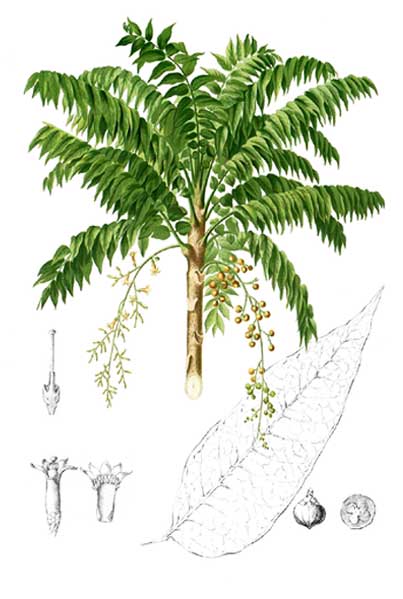
Family • Meliaceae
Igiu
Didymocheton gaudichaudianus A.Juss.
IVORY MAHOGANY
| Scientific names | Common names |
| Alliaria ammooroides (Miq.) Kuntze | Agaru (Pamp.) |
| Alliaria gaudichaudiana (A.Juss.) Kuntze | Aguiu (Pamp.) |
| Alliaria otophora (Miq.) Kuntze | Ananangtang (Bik.) |
| Alliaria spanoghei (Miq.) Kuntze | Bakugan (Bik.) |
| Didymocheton albiflorus (C.DC.) Harms | Basiloag (Ilk.) |
| Didymocheton amooroides (Miq.) Harms | Bolong-tambag (Bik.) |
| Didymocheton betchei (C.DC.) Harms | Bongliu (Bik.) |
| Didymocheton decandrus (Blanco) Harms | Bundugon (Bik.) |
| Didymocheton gaudichaudianus A.Juss. | Buntog (Bik.) |
| Didymocheton maota (Reinecke) Harms | Buntogan (Bik.) |
| Didymocheton spanoghei (Miq.) Harms | Himamao (Tag.) |
| Dysoxylum albiflorum C.DC. | Igiu (Tag., Pamp.) |
| Dysoxylum amooroides Miq. | Ikuo (Tag.) |
| D. amooroides var. otophorum (Miq.) Koord. & Valeton | Kugiug (Tag.) |
| Dysoxylum amooroides var. pubescens Hochr. | Makasisi (Bik.) |
| Dysoxylum bakerarum Guillaumin | Malaaduas (P. Bis.) |
| Dysoxylum betchei C.DC. | Malabaga (Pamp.) |
| Dysoxylum blancoi Vidal | Malabangau (Tag.) |
| Dysoxylum decandrum (Blanco) Merr. | Manangtang (Bik.) |
| Dysoxylum gaudichaudianum (A.Juss) Miq. | Palo-hambobokag (Bik.) |
| Dysoxylum intermedium Merr. & L.M.Perry | Paluahan (P. Bis.) |
| Dysoxylum macrophyllum Teijsm. & Binn. | Pamatagin (Ibn.) |
| Dysoxylum maota Reinecke | Pasiloag (Ilk.) |
| Dysoxylum otophorum Miq. | Tadiang-kalabau (Tag.) |
| Dysoxylum pubescens Teijsm. & Binn. | Tauing-tauing (Mbo.) |
| Dysoxylum quaifei C.DC. | Taliktan (Tag., Pamp.) |
| Dysoxylum rufum var. glabrescens Benth. | Ivory mahogany (Engl.) |
| Dysoxylum salutare Fern.-Vill. | |
| Dysoxylum spanoghei Miq. | |
| Dysoxylum vestitum Warb. | |
| Turraea decandra Blanco | |
| Turraea virens Blanco | |
| Dysoxylum decandrum (Blanco) Merr. is a synonym of Dysoxylum gaudichaudianus A.Juss. | |
| Dysoxylum gaudichaudianum (A.Juss.) Miq. is an accepted species. KEW: Plants of the World Online | |
| Other vernacular names |
| FRENCH: Dysoxylon de Gaudichaud. |
| INDONESIAN: Meda lasan. |
| PAPUA NEW GUINEA: Naukisua. |
| VANUATU: Eamopul, Nakau poa. |
Gen info
• Ivory mahogany is a large tree growing up to 36 m (118 ft) in height with a straight trunk up to 80 cm (31 in) diameter. The bark is smooth and often has teaspoon-sized depressions in it. Buttress roots are a feature of this tree and may reach up to 2.5 m (8 ft 2 in) high and 3.5 m (11 ft) wide. The very large leaves are produced in whorls and clustered towards the ends of the branches. They are imparipinnate with up to 14 pairs of leaflets, and measure up to 125 cm (49 in) in length. This arrangement produces large spherical clusters of foliage (see gallery). Leaflets are highly asymmetric at the base with one side of the leaf blade wider than the other. They measure up to 30 by 8 cm (11.8 by 3.1 in). Inflorescences are thyrses, about 70 cm (28 in) long, and produced in or close to the leaf axils. Flowers are a pale cream or green, 5-merous, with an unpleasant smell. Fruits are capsules about 3 cm (1.2 in) diameter which are covered in fine brown hairs. They have five segments and contain up to 10 seeds about 1 cm (0.39 in) long. (13)
Constituents Properties Toxicity concern Availability |
Updated September 2025 /February 2020 / January 2015
![]()
 |
PHOTOS / ILLUSTRATIONS |
| IMAGE SOURCE: Dysoxylum gaudichaudianum leaves and developing fruit / by Steve Fitzgerald / CC BY-SA 4.0 International / Image modified / Click on image or link to go to source page / Wikimedia Commons |
| OTHER IMAGE SOURCE: Ivory mahogany (Didymocheton gaudichaudianus / © Kenneth R Wood (NTBG) / CC BY-NC 4.0 International Deed / Image modified / Click on image or link to go to source page / iNaturalist |
| OTHER IMAGE SOURCE: Ivory mahogany fruit (Didymocheton gaudichaudianus / © ryanthughes / CC BY-NC 4.0 International Deed / Image modified / Click on image or link to go to source page / iNaturalist |
| OTHER IMAGE SOURCE: Ivory mahogany (Didymocheton gaudichaudianus / © Ian Cowan / CC BY-NC 4.0 International Deed / Image modified / Click on image or link to go to source page / iNaturalist |
| OTHER IMAGE SOURCE: Dysoxylum gaudichaudianum leaf / © David Tng / Non-commercial use / Image modified / Click on image or link to go to source page / Leaf Whispering in the Tropics |
Additional
Sources and Suggested Readings |
• |
DOI: It is not uncommon for links on studies/sources to change. Copying and pasting the information on the search window or using the DOI (if available) will often redirect to the new link page. (Citing and Using a (DOI) Digital Object Identifier) |
| Â Â Â Â Â Â Â Â Â Â Â Â Â Â Â Â Â Â Â Â Â Â Â Â Â Â Â Â Â Â List of Understudied Philippine Medicinal Plants |
| Â Â Â Â Â Â Â Â Â Â Â Â Â Â Â Â Â Â Â Â Â New plant names needed The compilation now numbers over 1,730 medicinal plants. While I believe there are hundreds more that can be added to the collection, they are becoming more difficult to find. If you have a plant to suggest for inclusion, native or introduced, please email the info: scientific name (most helpful), local plant name (if known), any known folkloric medicinal use, and, if possible, a photo. Your help will be greatly appreciated. |
• |
 |


 Botany
Botany Distribution
Distribution - In Papua New Guinea, the leaves and bark are used for treating rigid limbs, facial distortion in children, lumps under the skin, skin irritations, and sexually transmitted diseases. Also used for fish poisoning and convulsions. Decoction of chopped leaves used as cure for aches and pains; also for lung hemorrhage. (
- In Papua New Guinea, the leaves and bark are used for treating rigid limbs, facial distortion in children, lumps under the skin, skin irritations, and sexually transmitted diseases. Also used for fish poisoning and convulsions. Decoction of chopped leaves used as cure for aches and pains; also for lung hemorrhage. (